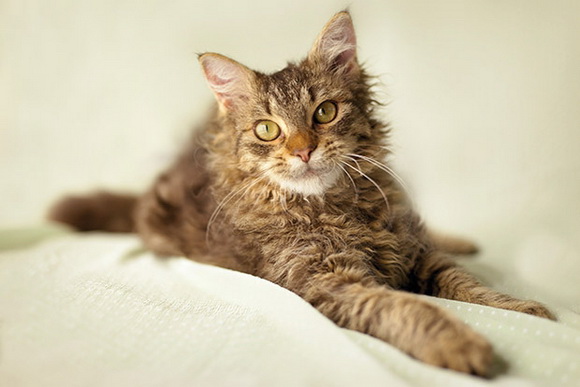General Description and History
The LaPerm cat, known for its distinctive shaggy curls and ringlets, is an intelligent and active breed with a unique history. The breed’s origin traces back to March 1, 1982, when Linda Koehl discovered a hairless kitten with large ears and a tabby pattern in her cherry orchard barn. Named Curly, this kitten later developed a soft wavy coat, giving birth to the LaPerm breed. Over time, more curly-coated kittens appeared, and the breed was officially recognized by TICA in 1995 and achieved Championship status in 2003.
Personality
LaPerm cats are clever and inquisitive, known for their mischievous and clown-like behavior. They enjoy human companionship, often following their owners around, riding on shoulders, or lounging beside them on the couch. These affectionate and gentle cats get along well with children and other pets, making them ideal family companions. Their playful and curious nature ensures they are always engaging and entertaining.
Physical Traits
LaPerm cats have a medium to long, muscular body with loose, light curls and bouncy ringlets. The coat feels like mohair and comes in various colors, patterns, and eye colors. The longest curls are typically around the neck and ruff, while both coat lengths feature long curled whiskers and kinked eyebrows. The coat requires minimal maintenance due to its low shedding nature. Regular light combing and occasional bathing keep the coat in excellent condition.
LaPerm Cats in the United States
The LaPerm breed began in Oregon with Linda and Dick Koehl’s farm cats. The breed’s development involved several breeders, including Solvieg Pfleuger and Anne D Lawrence. The LaPerm Society of America (LPSA) was formed in 1997, contributing significantly to the breed’s recognition. TICA approved the breed for Championship status in 2003, with the first champion being Ch Dennigan’s French Maid of Shoalwater.
LaPerm Cats in the United Kingdom
The first LaPerm in the UK was Champion Uluru BC Omaste Po of Quincunx, imported in 2002. This foundation stock led to a successful breeding program in the UK, which now has the largest LaPerm breeding program worldwide. The LaPerm Cat Club played a pivotal role in promoting the breed, achieving Provisional Recognition in the GCCF in 2008 and full championship recognition in 2012.
LaPerm Cats Around the World
LaPerm breeding programs have spread globally, reaching Canada, New Zealand, Australia, South Africa, Japan, Germany, the Netherlands, Sweden, and Russia. Each country’s breeders contributed to the breed’s development and recognition. FIFe granted Provisional recognition to the LaPerm in 2013, further solidifying its global presence.
Care Guidelines
Litter: Use wood stove pellets for their absorbency and low odor. Maintain cleanliness by daily scooping and disinfecting the litter box weekly with a bleach solution.
Water: Provide filtered or bottled water to avoid contaminants. Add liquid chlorophyll to help with gum disease and bad breath.
Food: Feed fresh, natural, organic foods, avoiding preservatives. Transition kittens from three meals a day to two by six months. For dry food, use INNOVA or WYSONG, supplemented with raw meat or natural canned food. Rotate flavors to prevent boredom.
Health: Address diarrhea with fruit pectin or Knox Gelatin mixed in wet food. Introduce new kittens to existing pets gradually to minimize stress.
Toys: Supervise playtime and avoid small, hazardous toys. Ensure toys do not pose choking or injury risks.
This comprehensive care guide ensures that LaPerm cats remain healthy and happy, highlighting the breed’s unique history, personality, and care needs.

